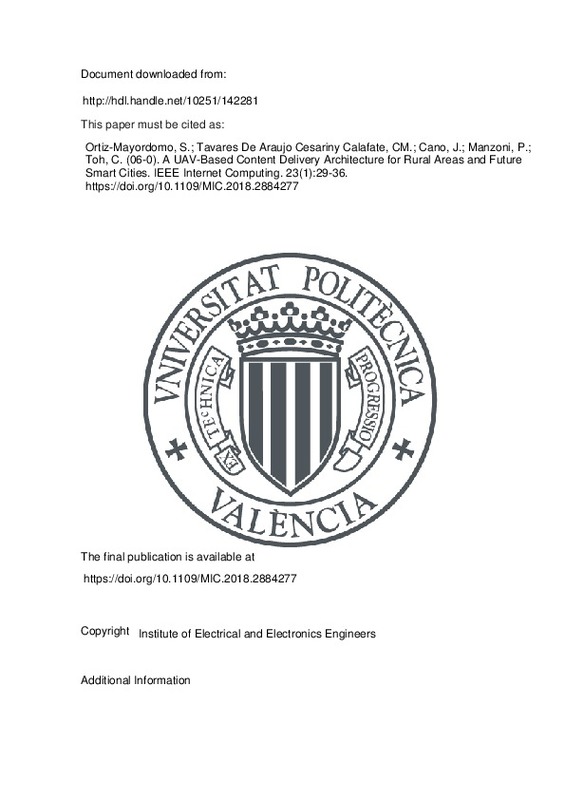JavaScript is disabled for your browser. Some features of this site may not work without it.
Buscar en RiuNet
Listar
Mi cuenta
Estadísticas
Ayuda RiuNet
Admin. UPV
A UAV-Based Content Delivery Architecture for Rural Areas and Future Smart Cities
Mostrar el registro sencillo del ítem
Ficheros en el ítem
| dc.contributor.author | Ortiz-Mayordomo, Sergio
|
es_ES |
| dc.contributor.author | Tavares De Araujo Cesariny Calafate, Carlos Miguel
|
es_ES |
| dc.contributor.author | Cano, Juan-Carlos
|
es_ES |
| dc.contributor.author | Manzoni, Pietro
|
es_ES |
| dc.contributor.author | Toh, C.K.
|
es_ES |
| dc.date.accessioned | 2020-05-05T06:18:45Z | |
| dc.date.available | 2020-05-05T06:18:45Z | |
| dc.date.issued | 2019-03-06 | es_ES |
| dc.identifier.issn | 1089-7801 | es_ES |
| dc.identifier.uri | http://hdl.handle.net/10251/142281 | |
| dc.description.abstract | [EN] Content delivery in vehicular environments can serve multiple purposes, such as safety, entertainment, and news delivery that can be geographically relevant to vehicles traveling within a certain area. The traditional approach to address this problem, based on fixed networking infrastructure, suffers from the following two drawbacks: First, the efficient delivery of large-sized contents to multiple moving receivers simultaneously can be hard to achieve, and second, most of the roads outside the main urban areas lack such fixed infrastructures due to economic reasons. In this paper, we tackle both these issues by proposing rapidly deployable wireless access infrastructures combining RaptorQ-protected content diffusion and unmanned aerial vehicles (UAVs). We performed experiments using actual vehicles and UAVs, and our results showed that RaptorQ-based content dissemination mechanisms is highly efficient when transmitting to multiple moving receivers simultaneously, and UAVs can serve as cheap, effective, and rapidly deployable mobile wireless access elements. | es_ES |
| dc.language | Inglés | es_ES |
| dc.publisher | Institute of Electrical and Electronics Engineers | es_ES |
| dc.relation.ispartof | IEEE Internet Computing | es_ES |
| dc.rights | Reserva de todos los derechos | es_ES |
| dc.subject | Roads | es_ES |
| dc.subject | Broadcasting | es_ES |
| dc.subject | Receivers | es_ES |
| dc.subject | Wireless communication | es_ES |
| dc.subject | Ad hoc networks | es_ES |
| dc.subject | Encoding | es_ES |
| dc.subject | Computer architecture | es_ES |
| dc.subject.classification | ARQUITECTURA Y TECNOLOGIA DE COMPUTADORES | es_ES |
| dc.title | A UAV-Based Content Delivery Architecture for Rural Areas and Future Smart Cities | es_ES |
| dc.type | Artículo | es_ES |
| dc.identifier.doi | 10.1109/MIC.2018.2884277 | es_ES |
| dc.relation.projectID | info:eu-repo/grantAgreement/AEI/Plan Estatal de Investigación Científica y Técnica y de Innovación 2017-2020/RTI2018-096384-B-I00/ES/SOLUCIONES PARA UNA GESTION EFICIENTE DEL TRAFICO VEHICULAR BASADAS EN SISTEMAS Y SERVICIOS EN RED/ | es_ES |
| dc.rights.accessRights | Abierto | es_ES |
| dc.contributor.affiliation | Universitat Politècnica de València. Departamento de Informática de Sistemas y Computadores - Departament d'Informàtica de Sistemes i Computadors | es_ES |
| dc.description.bibliographicCitation | Ortiz-Mayordomo, S.; Tavares De Araujo Cesariny Calafate, CM.; Cano, J.; Manzoni, P.; Toh, C. (2019). A UAV-Based Content Delivery Architecture for Rural Areas and Future Smart Cities. IEEE Internet Computing. 23(1):29-36. https://doi.org/10.1109/MIC.2018.2884277 | es_ES |
| dc.description.accrualMethod | S | es_ES |
| dc.relation.publisherversion | https://doi.org/10.1109/MIC.2018.2884277 | es_ES |
| dc.description.upvformatpinicio | 29 | es_ES |
| dc.description.upvformatpfin | 36 | es_ES |
| dc.type.version | info:eu-repo/semantics/publishedVersion | es_ES |
| dc.description.volume | 23 | es_ES |
| dc.description.issue | 1 | es_ES |
| dc.relation.pasarela | S\380453 | es_ES |
| dc.contributor.funder | Agencia Estatal de Investigación | es_ES |







![[Cerrado]](/themes/UPV/images/candado.png)

